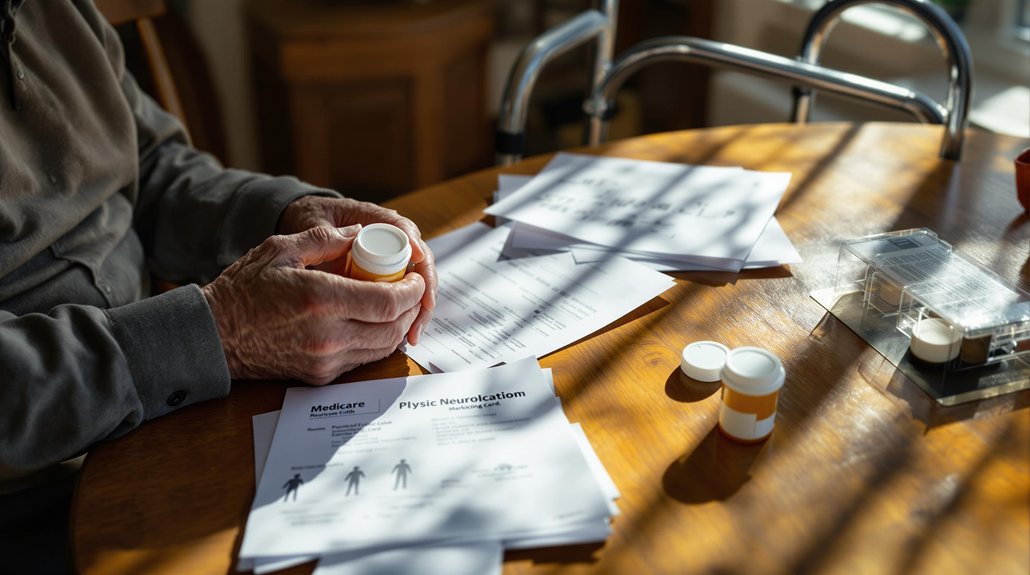The progression from Stage 1 to Stage 4 Parkinson’s typically takes 10-20 years, but your individual journey can vary considerably. Factors like your age at diagnosis, specific symptoms, and lifestyle choices influence how quickly the disease advances. If you have tremor-dominant symptoms, you might experience slower progression. Your exercise habits, nutrition, and access to healthcare can also impact your timeline. Understanding these factors will help you better prepare for each stage ahead.
Understanding the Staging System of Parkinson’s Disease
While Parkinson’s disease affects each person differently, doctors use established staging systems to track its progression and provide appropriate care.
The most common staging criteria help you understand where you or your loved one stands in the disease journey, enabling better preparation and support.
Understanding your Parkinson’s stage provides a roadmap for planning ahead and building the right support network.
During symptom assessment, medical professionals evaluate both motor and non-motor signs to determine the stage. They’ll look at factors like tremors, balance, daily task performance, and cognitive changes.
The standard five-stage scale runs from mild symptoms affecting one side of the body to advanced stages requiring extensive care.
Focus Family Care provides personalized home care services to help patients manage symptoms and maintain independence throughout each stage of the disease progression.
Key Factors Affecting Disease Progression Rate
Although each person’s Parkinson’s journey differs, several key factors influence how quickly the disease progresses. Your age at diagnosis plays a significant role, as earlier onset often leads to slower progression.
Your specific symptoms matter too – tremor-dominant Parkinson’s typically advances more slowly than postural instability and gait difficulty variants.
Genetics and family history contribute to progression variability, but you can impact your disease course through lifestyle factors. Regular exercise, proper nutrition, stress management, and consistent medication adherence may help slow progression.
Your support system and access to healthcare resources also affect your journey. By working closely with your healthcare team and maintaining healthy habits, you’ll be better equipped to manage your symptoms and potentially influence your disease’s progression rate. A comprehensive care plan developed through in-home assessments can help ensure proper support throughout each stage of Parkinson’s progression.
Early Warning Signs and Stage 1 Characteristics
The four earliest warning signs of Parkinson’s often appear years before diagnosis: slight hand tremors, reduced arm swing while walking, changes in handwriting, and loss of smell.
During Stage 1, you’ll notice mild early symptoms that don’t interfere with daily activities but may affect one side of your body.
As you support someone with Stage 1 Parkinson’s, watch for these characteristic motor changes:
- Occasional tremors in one hand, finger, or foot, typically when resting
- Slight stiffness or rigidity in neck and shoulders
- Minor changes in facial expressions, showing less emotion
- Subtle differences in posture and balance, especially when turning
Understanding these early indicators helps you provide better care and support for your loved one while working with healthcare providers to manage symptoms effectively.
Private duty nursing services can provide specialized medical attention during the early stages to help monitor symptoms and maintain quality of life.
Transitioning Through Stage 2 and Stage 3
Progression into Stages 2 and 3 brings noticeable changes that affect both sides of the body and daily activities. Your movements will become slower, and you’ll experience increased muscle stiffness, tremors, and balance issues.
During Stage 2, symptoms management focuses on medication adjustments and physical therapy to maintain independence.
Physical therapy and medication adjustments become crucial tools in Stage 2, helping patients maintain their independence through targeted symptom management.
As you evolve into Stage 3, daily challenges become more pronounced. You’ll find tasks like dressing, eating, and personal hygiene require more time and effort. Your posture may shift forward, and walking becomes increasingly difficult.
This stage often marks a turning point where you’ll need to modify your home environment and possibly accept help from others. While these changes can feel overwhelming, working closely with your healthcare team and support network helps you maintain the best possible quality of life. Consider implementing 24/7 care services to ensure comprehensive support and monitoring during this challenging transition period.
Recognizing Stage 4 Symptoms and Challenges
Stage 4 marks a significant decline in independence, as symptoms become severe enough to require substantial assistance.
You’ll notice your loved one experiencing increased mobility challenges that make daily tasks difficult to manage alone.
Key changes you’ll need to prepare for include:
- Severe balance issues requiring a walker or wheelchair for most movement
- Significant cognitive decline affecting memory and decision-making abilities
- Extended periods of freezing while walking, increasing fall risks
- Inability to live alone due to safety concerns and physical limitations
As a caregiver, you’ll need to adapt your support strategies to guarantee safety while helping maintain dignity.
Consider making home modifications and establishing a routine that accommodates slower movement patterns.
Professional care assistance might become necessary for tasks requiring physical strength or specialized medical knowledge.
Memory care support and cognitive activities provided by trained caregivers can help maintain mental function during this challenging stage.
Treatment Options Throughout Disease Progression
While Parkinson’s disease can’t be cured, numerous treatment options exist to help manage symptoms and improve quality of life throughout its progression.
You’ll work with your healthcare team to develop a personalized treatment plan that adapts as your needs change. Medication management forms the cornerstone of treatment, while physical therapy helps maintain mobility and independence.
| Stage | Medical Treatments | Non-Medical Approaches |
|---|---|---|
| Early | Levodopa, MAO-B inhibitors | Exercise, balance training |
| Moderate | Dopamine agonists, anticholinergics | Speech therapy, occupational therapy |
| Advanced | Deep brain stimulation | Assistive devices, home modifications |
| Late | Pain management, antidepressants | Caregiver support, daily living aids |
Your treatment journey may include complementary therapies like yoga, meditation, or acupuncture to enhance your overall well-being and symptom management.
Living Well With Advanced Parkinson’s Disease
Despite the challenges of advanced Parkinson’s disease, you can maintain a fulfilling life by adapting your daily routines and leveraging available support systems.
Making lifestyle adaptations and connecting with support networks helps you navigate this stage while continuing to contribute meaningfully to your community. Focus on activities that bring purpose and joy while working closely with your care team to manage symptoms effectively.
Stay connected and engaged through meaningful activities while adapting to changes – your contributions remain valuable despite Parkinson’s challenges.
- Join local Parkinson’s support groups to share experiences and learn coping strategies from others facing similar challenges.
- Modify your home environment with adaptive equipment to maintain independence and safety.
- Stay engaged with family and friends through modified social activities that accommodate your energy levels.
- Explore new hobbies or adapt existing ones to match your current abilities while still allowing you to help others.
Conclusion
Each person’s journey with Parkinson’s is different, just like no two snowflakes are alike. While it usually takes between 10 to 20 years to move from stage 1 to stage 4, your path may be different. Think of managing Parkinson’s like tending a garden – with proper care and attention, you can help shape how it grows. Today’s treatments are better than ever, and doctors are discovering new ways to help every day.
Remember, you don’t have to walk this path alone. It’s okay to ask for help, and it’s okay to have questions. We understand that some days might feel like climbing a mountain, while others might feel more like a gentle walk in the park. That’s why having caring support makes such a difference.
If you or a loved one need help, don’t wait. Reach out to Focus Family Care today at (561) 693-1311 or email us at info@focusfamilycare.com.




